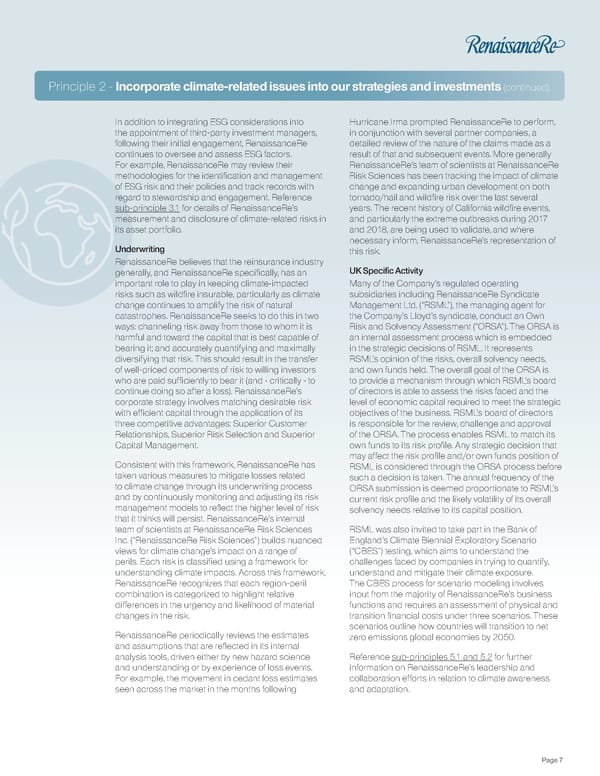Principle 2 - Incorporate climate-related issues into our strategies and investments (continued) In addition to integrating ESG considerations into Hurricane Irma prompted RenaissanceRe to perform, the appointment of third-party investment managers, in conjunction with several partner companies, a following their initial engagement, RenaissanceRe detailed review of the nature of the claims made as a continues to oversee and assess ESG factors. result of that and subsequent events. More generally For example, RenaissanceRe may review their RenaissanceRe’s team of scientists at RenaissanceRe methodologies for the identification and management Risk Sciences has been tracking the impact of climate of ESG risk and their policies and track records with change and expanding urban development on both regard to stewardship and engagement. Reference tornado/hail and wildfire risk over the last several sub-principle 3.1 for details of RenaissanceRe’s years. The recent history of California wildfire events, measurement and disclosure of climate-related risks in and particularly the extreme outbreaks during 2017 its asset portfolio. and 2018, are being used to validate, and where necessary inform, RenaissanceRe’s representation of Underwriting this risk. RenaissanceRe believes that the reinsurance industry UK Specific Activity generally, and RenaissanceRe specifically, has an important role to play in keeping climate-impacted Many of the Company’s regulated operating risks such as wildfire insurable, particularly as climate subsidiaries including RenaissanceRe Syndicate change continues to amplify the risk of natural Management Ltd. (“RSML”), the managing agent for catastrophes. RenaissanceRe seeks to do this in two the Company’s Lloyd’s syndicate, conduct an Own ways: channeling risk away from those to whom it is Risk and Solvency Assessment (“ORSA”). The ORSA is harmful and toward the capital that is best capable of an internal assessment process which is embedded bearing it; and accurately quantifying and maximally in the strategic decisions of RSML. It represents diversifying that risk. This should result in the transfer RSML’s opinion of the risks, overall solvency needs, of well-priced components of risk to willing investors and own funds held. The overall goal of the ORSA is who are paid sufficiently to bear it (and - critically - to to provide a mechanism through which RSML’s board continue doing so after a loss). RenaissanceRe’s of directors is able to assess the risks faced and the corporate strategy involves matching desirable risk level of economic capital required to meet the strategic with efficient capital through the application of its objectives of the business. RSML’s board of directors three competitive advantages: Superior Customer is responsible for the review, challenge and approval Relationships, Superior Risk Selection and Superior of the ORSA. The process enables RSML to match its Capital Management. own funds to its risk profile. Any strategic decision that may affect the risk profile and/or own funds position of Consistent with this framework, RenaissanceRe has RSML is considered through the ORSA process before taken various measures to mitigate losses related such a decision is taken. The annual frequency of the to climate change through its underwriting process ORSA submission is deemed proportionate to RSML’s and by continuously monitoring and adjusting its risk current risk profile and the likely volatility of its overall management models to reflect the higher level of risk solvency needs relative to its capital position. that it thinks will persist. RenaissanceRe’s internal team of scientists at RenaissanceRe Risk Sciences RSML was also invited to take part in the Bank of Inc. (“RenaissanceRe Risk Sciences”) builds nuanced England’s Climate Biennial Exploratory Scenario views for climate change’s impact on a range of (“CBES”) testing, which aims to understand the perils. Each risk is classified using a framework for challenges faced by companies in trying to quantify, understanding climate impacts. Across this framework, understand and mitigate their climate exposure. RenaissanceRe recognizes that each region-peril The CBES process for scenario modeling involves combination is categorized to highlight relative input from the majority of RenaissanceRe’s business differences in the urgency and likelihood of material functions and requires an assessment of physical and changes in the risk. transition financial costs under three scenarios. These scenarios outline how countries will transition to net RenaissanceRe periodically reviews the estimates zero emissions global economies by 2050. and assumptions that are reflected in its internal analysis tools, driven either by new hazard science Reference sub-principles 5.1 and 5.2 for further and understanding or by experience of loss events. information on RenaissanceRe’s leadership and For example, the movement in cedant loss estimates collaboration efforts in relation to climate awareness seen across the market in the months following and adaptation. Page 7
 2022 ClimateWise Report Page 8 Page 10
2022 ClimateWise Report Page 8 Page 10